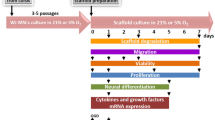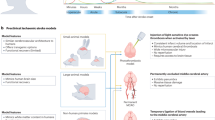Abstract
Stroke results in the disruption of tissue architecture and is the third leading cause of death in the United States1. Transplanting scaffolds containing stem cells into the injured areas of the brain has been proposed as a treatment strategy2, and carbon nanotubes show promise in this regard, with positive outcomes when used as scaffolds in neural cells3,4 and brain tissues5. Here, we show that pretreating rats with amine-modified single-walled carbon nanotubes can protect neurons and enhance the recovery of behavioural functions in rats with induced stroke. Treated rats showed less tissue damage than controls and took longer to fall from a rotating rod, suggesting better motor functions after injury. Low levels of apoptotic, angiogenic and inflammation markers indicated that amine-modified single-walled carbon nanotubes protected the brains of treated rats from ischaemic injury.
This is a preview of subscription content, access via your institution
Access options
Subscribe to this journal
Receive 12 print issues and online access
$259.00 per year
only $21.58 per issue
Buy this article
- Purchase on Springer Link
- Instant access to full article PDF
Prices may be subject to local taxes which are calculated during checkout




Similar content being viewed by others
References
Kissela, B. et al. Greater Cincinnati/Northern Kentucky stroke study: volume of first-ever ischaemic stroke among blacks in a population-based study. Stroke 32, 1285–1290 (2001).
Park, K. I., Teng, Y. D. & Snyder, E. Y. The injured brain interacts reciprocally with neural stem cells supported by scaffolds to reconstitute lost tissue. Nature Biotechnol. 20, 1111–1117 (2002).
Gheith, M. K. et al. Stimulation of neural cells by lateral layer-by layer films of single-walled currents in conductive carbon nanotubes. Adv. Mater. 18, 2975–2979 (2006).
Cellot, G. et al. Carbon nanotubes might improve neuronal performance by favouring electrical shortcuts. Nature Nanotech. 4, 126–133 (2008)
Keefer, E. W., Botterman, B. R., Romero, M. I., Rossi, A. F. & Gross, G. W. Carbon nanotube coating improves neuronal recordings. Nature Nanotech. 3, 434–439 (2008).
Kim, D. H. et al. Milk with brain factor-7 (BF-7 milk) enhances attention and cognition in normal persons. Milchwissenschaft 64, 300–304 (2009).
Xu, X., Chua, C. C., Gao, J., Hamdy, R. C. & Chua, B. H. Humanin is a novel neuroprotective agent against stroke. Stroke 37, 2613–2619 (2006).
Matsumoto, K., Sato, C., Naka, Y., Whitby, R. & Shimizu, N. Stimulation of neuronal neurite outgrowth using functionalized carbon nanotubes. Nanotechnology 21, 115101 (2010).
Wang, W., Fishman, H. A., Dai, H. & Harris, J. S. Neural stimulation with a carbon nanotube microelectrode array. Nano Lett. 6, 2043–2048 (2006).
Yoon, O. J. et al. Nanocomposites of electrospun poly[(D,L-lactic)-co-(glycolic acid)] and plasma-functionalized single-walled carbon nanotubes for biomedical applications. Plasm. Proc. Polym. 6, 101–109 (2009).
Chen, C. et al. Amino group introduction onto multiwall carbon nanotubes by NH3/Ar plasma treatment. Carbon 48, 939–948 (2010).
Stoll, G., Jander, S. & Schroeter, M. Inflammation and glial responses in ischaemic brain lesions. Prog. Neurobiol. 56, 149–171 (1998).
Jordán, J., Segura, T., Brea, D., Galindo, M. F. & Castillo, J. Inflammation as therapeutic objective in stroke. Curr. Pharm. Des. 14, 3549–3564 (2008).
Chopp, M., Zhang, Z. G. & Jiang, Q. Neurogenesis, angiogenesis, and MRI indices of functional recovery from stroke. Stroke 38, 827–831 (2007).
Zhang, Z. G. & Chopp, M. Neurorestorative therapies for stroke: underlying mechanisms and translation to the clinic. Lancet Neurol. 8, 491–500 (2009).
Janelidze, S., Hu, B. R., Siesjo, P. & Siesjo, B. K. Alterations of akt1 (pkbalpha) and p70(s6k) in transient focal ischaemia. Neurobiol. Dis. 8, 147–154 (2001).
Zhao, H., Sapolsky, R. M. & Steinberg, G. K. Phosphoinositide-3-kinase/akt survival signal pathways are implicated in neuronal survival after stroke. Mol. Neurobiol. 34, 249–270 (2006).
Liu, C. et al. Neuroprotection by baicalein in ischaemic brain injury involves PTEN/AKT pathway. J. Neurochem. 112, 1500–1512 (2010).
Inoue, A. & Sanes, J. R. Lamina-specific connectivity in the brain: regulation by N-cadherin, neurotrophins, and glycoconjugates. Science 276, 1428–1431 (1997).
Okabe, T. et al. RICS, a novel GTPase-activating protein for Cdc42 and Rac1, is involved in the beta-catenin-N-cadherin and N-methyl-D-aspartate receptor signaling. J Biol.Chem. 278, 9920–9927 (2003).
Costain, W. J. et al. Cerebral ischaemia causes dysregulation of synaptic adhesion in mouse synaptosomes. J. Cereb. Blood Flow Metab. 28, 99–110 (2008).
Craighead, H. G., James, C. D. & Turner, A. M. P. Chemical and topographical patterning for directed cell attachment. Curr. Opin. Sol. Stat. Mater. Sci. 5, 177–184 (2001).
Lee, W. & Parpura, V. Wiring neurons with carbon nanotubes, Front. Neuroeng. 2, 1–3 (2009).
Acknowledgements
This work was supported by grants from the BioGreen21 Program (PJ007079) and the Basic Science Research Programs (KRF-2008-532-E00023 and 2010-0015035).
Author information
Authors and Affiliations
Contributions
H.J.L. and S.S.K. conceived and designed the experiments. H.J.L. and J.P. performed the experiments. H.J.L., O.J.Y., N.-E.L., W.B.L. and S.S.K. analysed the data. H.J.L., J.P., O.J.Y. and H.W.K. contributed to materials/analysis tools. H.J.L., O.J.Y., D.Y.L., D.H.K., N.-E.L., J.V.B. and S.S.K. evaluated the data and co-wrote the paper.
Corresponding author
Ethics declarations
Competing interests
The authors declare no competing financial interests.
Supplementary information
Supplementary information
Supplementary information (PDF 1092 kb)
Rights and permissions
About this article
Cite this article
Lee, H., Park, J., Yoon, O. et al. Amine-modified single-walled carbon nanotubes protect neurons from injury in a rat stroke model. Nature Nanotech 6, 121–125 (2011). https://doi.org/10.1038/nnano.2010.281
Received:
Accepted:
Published:
Issue Date:
DOI: https://doi.org/10.1038/nnano.2010.281
This article is cited by
-
Surface-Tailored Nanoplatform for the Diagnosis and Management of Stroke: Current Strategies and Future Outlook
Molecular Neurobiology (2024)
-
Design of therapeutic biomaterials to control inflammation
Nature Reviews Materials (2022)
-
The neuroprotective effect of pretreatment with carbon dots from Crinis Carbonisatus (carbonized human hair) against cerebral ischemia reperfusion injury
Journal of Nanobiotechnology (2021)
-
Carbon Nanotubes in Biomedicine
Topics in Current Chemistry (2020)
-
Systemic Administrations of Water-Dispersible Single-Walled Carbon Nanotubes: Activation of NOS in Spontaneously Hypertensive Rats
Neurophysiology (2020)



